#afghan pamir
Photo

Kyrgyz women in the little Pamir.
Source: Silvia Alessi
#afghanistan#afghan#afghan people#kyrgyz#turkic#minority#asia#ethnic group#central asia#south asia#pamir#badakhshan#wakhan#wakhan corridor#rural#nature#women#veil#river#landscape#mountains#high res#asian culture#traditional clothes#nomad#nomadic
460 notes
·
View notes
Text
Hi lovelies,
A few days ago this new Bollywood movie called Pathaan, starring Shah Rukh Khan and John Abrahams, came out and so obviously I HAD to go and watch it. But fun fact about me is that I am literally a melting pot of different cultures. My dads family are Indian-Kenyan. My mums family were initially (back in the 5th-7th century) a family of Jewish royalty in what is now Afghanistan (which is actually pretty cool). They converted to Islam some time later and became part of a very particular Afghani tribe called the Pathaan (also another reason I had to watch this movie). Over the course of the next few centuries they migrated from Afghanistan to India, before being forced into Pakistan because of colonialism. Throughout all of this, my mums branch of the Pathaan tribe stuck together and so even still, my mum’s family in pure Pathaan, but I’m only half Pathaan because my mum married out. However, me being me did some deep diving into this because it’s actually pretty cool that my family tree can be traced back that far. Okay so at this point you’re probably wondering how on earth this related to Classics, but I found out that the Pathaan langue (Pashto) is actually about 2500 years old, which makes it about the same age as Latin and therefore a classical language! And so today I thought I would tell you a little bit about Pashto.
The Pashto language belongs to the Indi-Iranian language family and is mainly spoken by the ethnic communities of Afghanistan and western provinces of Pakistan, which is partially inhabited by Pashtuns (aka Pathaan’s). It is also still the native language of the indigenous Pathaan people. The language is said to have originated in the Kandahar district of Afghanistan and is said to be one of the two national languages (the other being Dari, a Persian language).
The vocabulary of Pashto has actually not been borrowed or derived from other languages, which is extremely rare for any language still spoken in a modern setting. Many of its lexis do, however, relate to other Eastern Iranian languages such as Pamir and Ossetia.
The exact origin of the Pashto language and the Pathaan tribes are unknown, but the word ‘Pashto’ derives from the regular phonological process. Nevertheless, the Pathaan are sometimes compared with the Pakhta tribes mentioned in Rigvenda, around 1700-1100 B.C., apparently they are the same people that the Greek historian Herodotus referred to Paktika (a northern province in Afghanistan). However, this comparison appears to be due in large part to the apparent similarity between their names, despite the fact that etymologically it can’t really be justified. But there are some archeological compilations and historical data and so the majority of researchers now believe that the Pashto language is around 25000 years old.
Herodotus also mentions the Paktika ‘Apridai’ tribe but it is unknown what language they spoke. However, Strabo (who lived between 64 B.C. and 24 C.E.) suggests that the tribes inhabiting the lands west of the Indus River were part of Ariana and to their east was India. Since about the 3rd century B.C. and onwards from that, these tribes were mostly referred to by the name ‘Afghan’ (or ‘Abgan’) and their language as ‘Afghani’.
Many historians and scholars believe that the earliest piece of written Pashto work dates back to the 8th century. However, a lot of history outside of the western empires lacks the same clarity and information and so even this is highly disputed. However, during the 17th century, Pashto poetry became very popular amongst the Pathaan.
To be honest, there isn’t a whole lot of information on the Pashtun language or the origin of the Pathaan, other than that they have been around since the B.C. But it’s pretty cool to me that my families culture has such a long history. This entry was pretty special to me so hopefully you all enjoyed it and I hope you all have a lovely rest of your weekend!
~Z
#classical studies#classics#ancient rome#ancient greece#dark acamedia#ancient world#history#afghanistan#pakistan#shah rukh khan#pathaan#deepikapadukone#origin story#sorry guys#this#is just#me rambling#im a nerd#john abraham#is like#my childhood#celeb crush#also
26 notes
·
View notes
Text
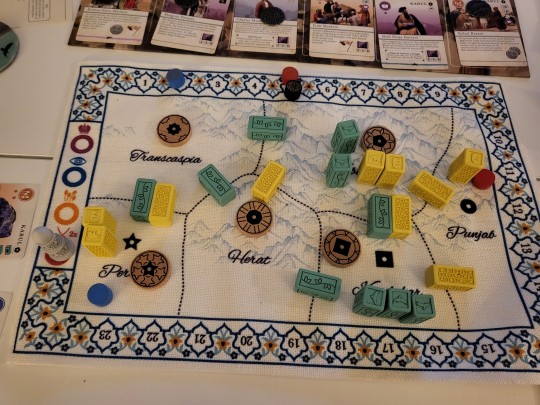
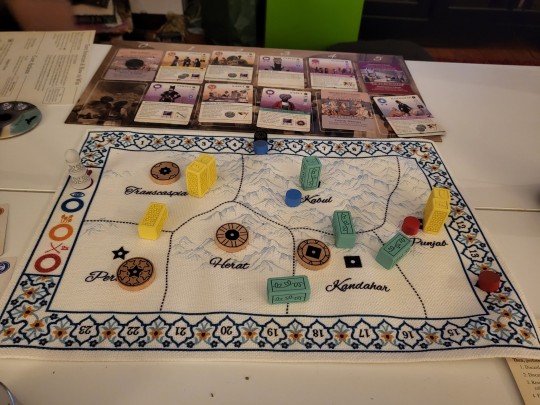
A tenuous Afghan alliance gave way to an explosive Russo-Afghan conflict tonight in Pax Pamir. One player broke ranks with the Afghan nationalists after falling out of their favor, alligning with the Russians with a glut of military advisors. Outmanned, the conflict reached a standstill with the game being determined by spies.
4 notes
·
View notes
Text
Et finalement, le Tadjikistan 3/4 -
Wakhan partie 1
Quelques nuits dans un lit, des petits déjeuners pantagruéliques et de nouvelles rencontres plus tard (coucou Anne et Ersin !), nous sommes presque prêts à repartir de Khorog pour entamer la deuxième boucle à travers le Pamir. Presque, car on attend la livraison depuis Douchanbé par Moritz, un cycliste allemand rencontré sur la route, de deux nouvelles bouteilles de gaz… Car oui c’est officiel, l’utilisation du réchaud à l’essence n’est vraiment pas un succès pour nous. On n’a toujours pas compris quel était vraiment le problème mais en résumé ça ne marche pas (déjà que l’essence ça pue…) et comme on ne tient pas à manger du pain sec pendant les 20 prochains jours, on décide de jouer la sécurité. Ici le gaz est difficile à trouver, surtout depuis que la frontière entre le Tadjikistan et le Kirghizstan est fermée, on attend donc notre livraison avec impatience.
C’est dans la brume, et en compagnie du jeune Moritz et du pas très jeune Fritz (un autre allemand qu’on rencontre dès les premiers coups de pédale), qu’on s’élance cette fois dans la vallée de Wakhan, qui longe l’Afghanistan le long du corridor du même nom. Cette fine bande de terre sépare le Pamir tadjik de l’Hindu Kush pakistanais et ses très hautes montagnes (ça en jette). On se perd rapidement de vue mais on échange nos deux allemands pour deux français de Lyon, Camille et Romain, qui relient la France au Japon à vélo (rien que ça !). Le lendemain, on fait cette fois la connaissance de Julie et Valère, encore des Rhônealpins (oui c’est moche mais on avait envie, c’est notre blog après tout) qui vont au Japon. Ces quatre-là se connaissent déjà et c’est avec eux qu’on vivra ces quelques jours intenses dans cette belle mais difficile vallée. Enfin on dit difficile mais le début passe franchement bien, on avale près de 100 km le premier jour et le deuxième on passe plein de temps à papoter avec la troupe de cyclistes qu’on rencontre (on pique-nique même avec pas moins de 9 autres cyclistes !). Cette douce illusion prend rapidement fin - le temps de s’enfoncer suffisamment dans la vallée pour renoncer à faire demi-tour : tôle ondulée (ces petites bosses bien dures qui nous secouent de la tête au pied et nous permettent d’annoncer notre arrivée avec fracas, tels des quincailliers ambulants), sable, cailloux trop gros ou trop petits, soleil qui tabasse la journée et froid piquant de la nuit. La Wakhan (c’est comme ça qu’on dit dans le milieu) nous fera puiser dans nos réserves. C’est dans ces conditions d’effort intense qu’on apprend à connaître nos nouveaux ami.e.s, ça joue certainement sur l’étroitesse des liens qu’on tisse avec eux, l’isolement et l’effort semblant prêter aux confidences. En plus du soutien psychologique, on bénéficie pas mal du filtre à eau de très bonne facture de Julie et Valère… Quand nous on galère à purifier un litre par demi-heure (voire plus !), ils possèdent une machine de guerre qui, en trois coups de pompe, peut transformer une rivière boueuse en Cristaline à biberons. C’est bien pratique quand on pédale une centaine de kilomètres sans croiser de villages ! On finit par quitter le liseré de la frontière afghane, ses postes de surveillance sommairement aménagés et ses nonchalantes patrouilles de militaires à peine pubères, pour piquer vers le nord via le col de Kargush (4300 m). On est agréablement surpris par la « facilité » de la montée, heureusement qu’on est cueillis par un plateau sableux de l’autre côté, sinon la journée aurait été trop facile… Les retrouvailles avec l’asphalte quelques kilomètres plus loin nous arrachent quelques larmes, comme quoi on a bien été poussés dans nos retranchements.
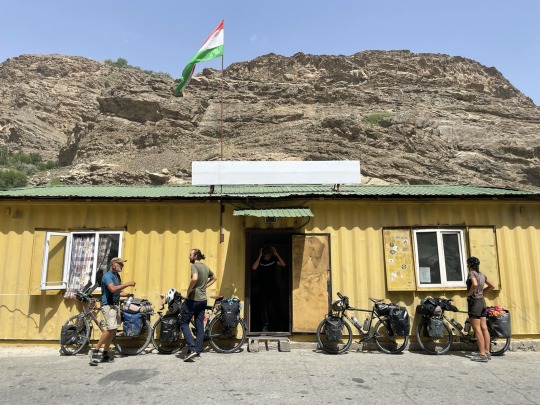
Fritz & Moritz à la pause thé abricots chez les bidasses (km 2)
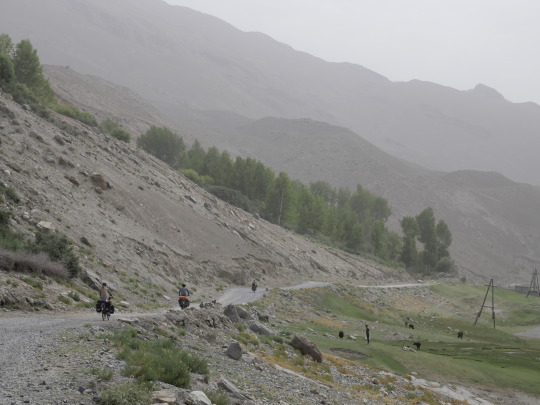
Wakhan la brumeuse.

Échantillon de tôle ondulée.
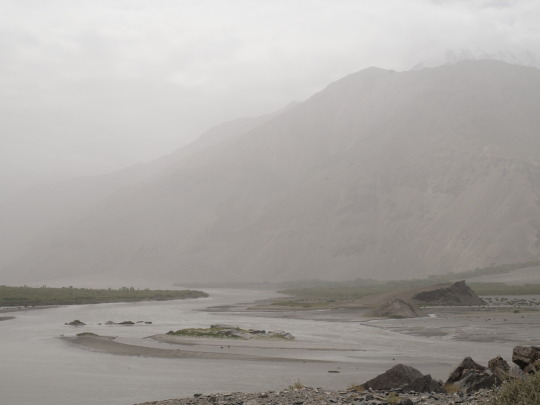

Méandres afghans.
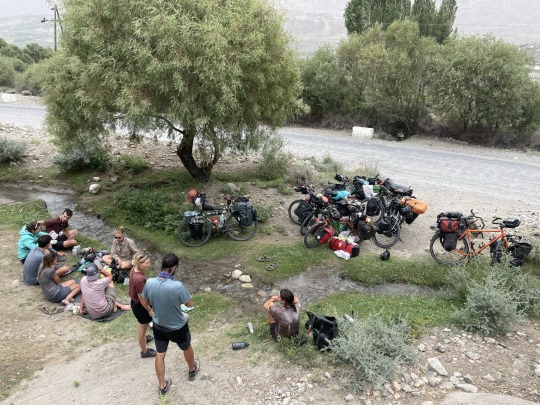
Pique-nique au sommet.
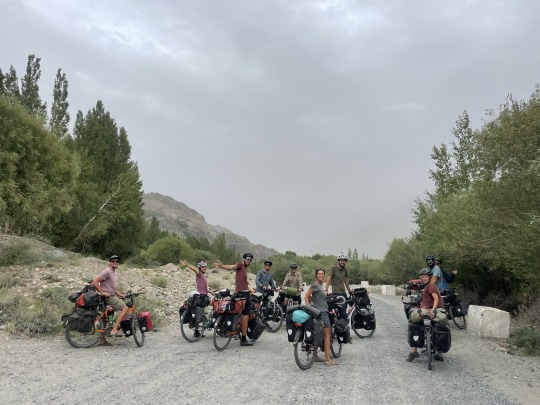
Une journée classée noire selon bison futé.

"S'aimer c'est regarder ensemble dans la même direction" (feat. Julie & Valère)

De l'autre coté l'Afghanistan.
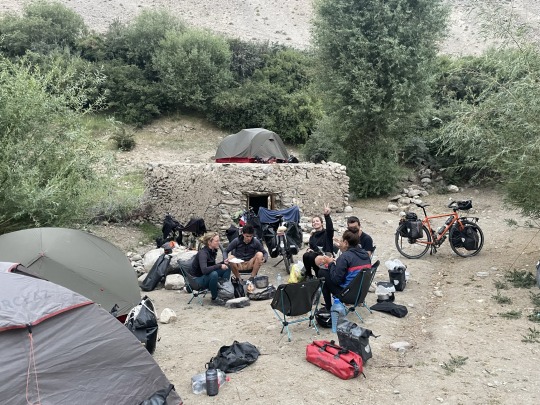
Campement français.

"Pas de réseau..."

Dyslexie de panneau.

En bas à droite sur la piste, on peut voir les tout petits Julie et Valère.

Copains chinois.

La fatigue.
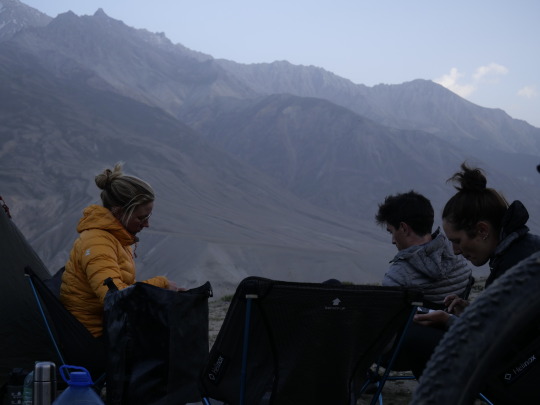
Menu sarrasin-oignon-poivron.
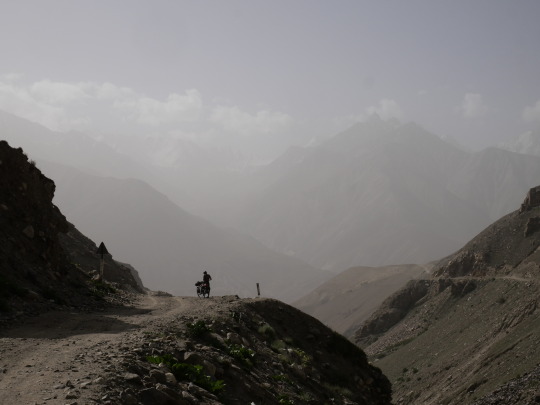
La vie dans la caillasse.

Des cailloux des cailloux...

Pas un arbre pour se mettre à l'ombre.

"Moins de sable svp"
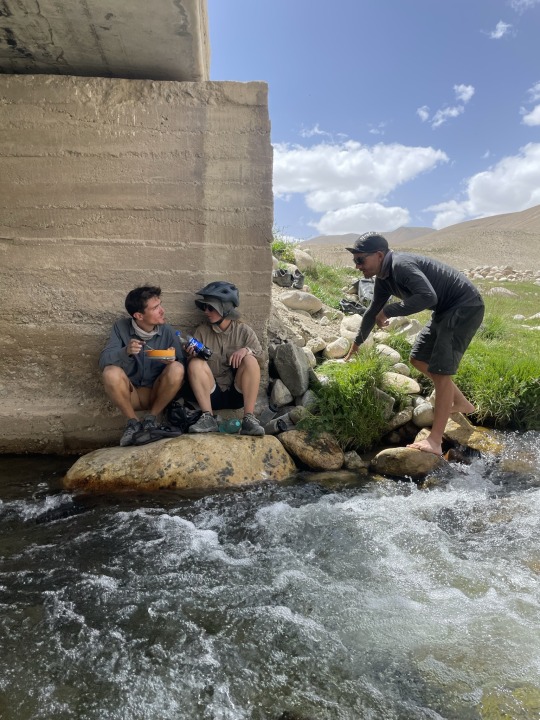
L'ombre, ce bien précieux.
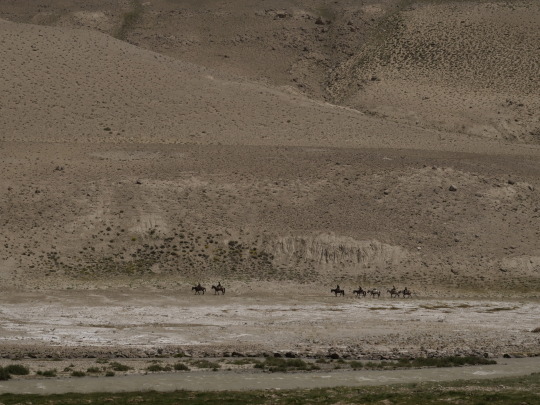
Caravane afghane.

Presque caravane tadjike.
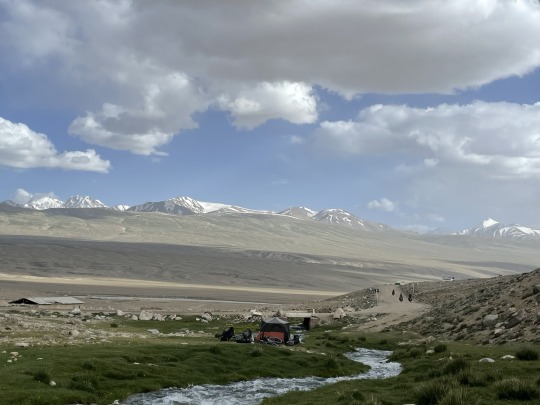
Dernière nuit avant le col.

C'est finiiiii !
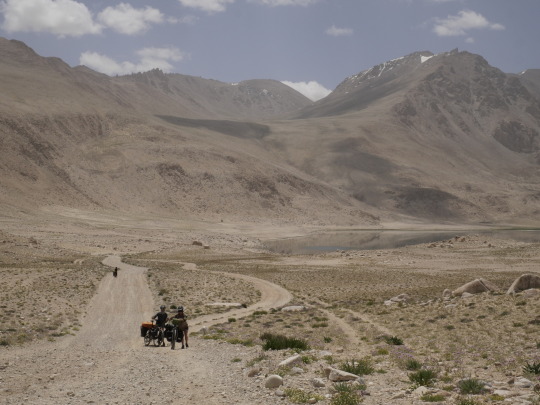
Ah non pas tout à fait.

"Attention zigzag"

Bonjour à toi gentil asphalte.
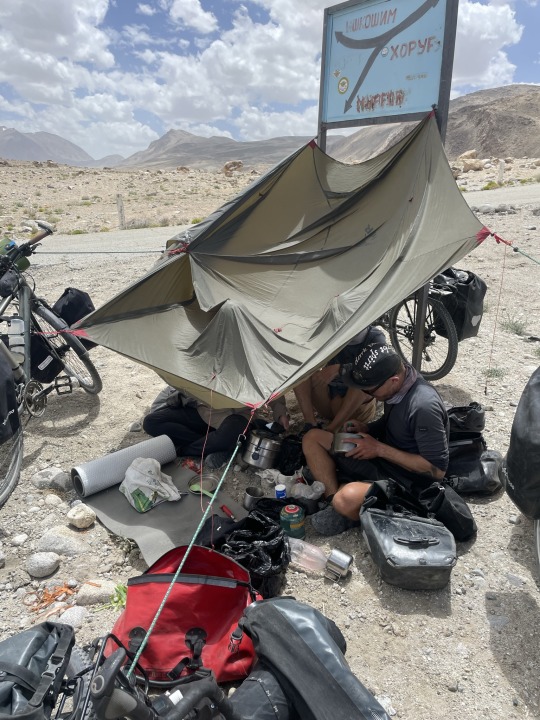
Comme à la maison.
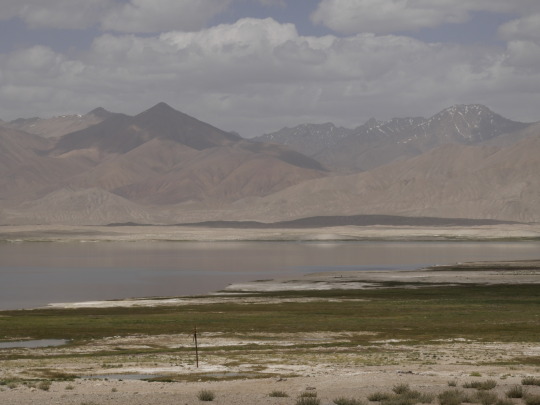
Lac non-potable.
0 notes
Text
An Afghan Girl
My unbarred thoughts,
the free immigrant birds of my childhood
My gleaming eyes, the bright light of Kohi-i-Noor
My soft lips, the glow of Darul Aman apple gardens
My hands, the strength of my mother’s heart
My passion, the winding thoughts of the village girls
My hair, the depth of darkness of the Pamir Mountains
My breasts, pure yet fully grown, eager and firm
My tongue, the mix of spices of Kashmir and Kabul
Each, one by one, separately
Shimmer through the true identity of an Afghan girl
Shahla Latifi
June 2022
0 notes
Text
The territory from Azerbaijan to Punjab anthropologically represents the area of the Indo-Afghan branch of the Caucasians, one of the earliest carriers of an Indo-European speech. In the southeast, Indus Valley is included in the original area. In the northwest, Eastern Transcaucasia (in particular, the valleys of the Kura and Araks river) are included in the range of Indo-Afghans.
“The Chalcolithic inhabitants of Mehrgarh in Baluchistan from at least 4500BCE were anthropologically related to the inhabitants of Harappa of the bronze age – typical Indo-Afghans.
Indo-Afghans have lived at the junction of Iran and Hindustan since at least the Neolithic era, as evidenced by the paleoanthropological study of the skeletons of the neolithic settlement Sang-e-Chakhmaq in northeastern Iran.
Sang-e-Chakhmaq in northeastern Iran in both sexes, the average cranial index of all individuals falls on dolichocrania, but close to hyperdolichocrania of people of the Mediterranean type identified in the skulls of the periods Sialk from I to IV and Hissar III, although the faces from Sang-e-Chakhmaq were not so narrow.
Djeitun culture people were also already of the Indo-Afghan anthropological type. In the south of central Asia, the valley of the Zeravshan river served as the northern boundary of the Indo-Afghans' area in the Eneolithic and Bronze Ages.
North-Indian variant of the Indo-Afghan type includes large ethno-caste groups of the population of northern India – Jats, Rajputs, Brahmins, Gujars, Ahirs, etc.
Dolichocranic Caucasoid (Mediterranean) type is characteristic of the regions to the south and west of the Amu Darya, where it has been predominant since the bronze age (for example, Djeitun derived Anau and Namazga Tepe in Turkmenistan) to the present (Turkmenistan, Iran, Northern India and the southern slopes of the Hindu Kush).
The population of the south of the Pamir in the 1stMillenniumBCE – 1stmillenniumAD also had a pronounced dolichocranic caucasoid type. The same type was characteristic there for the population of the Saka culture and for later times, at least until the middle of the 1stmillenniumBCE. In the bronze age, the dolichocranic caucasoid type was widespread north of the Amu Darya, in Bactria and Sogdiana and Ferghana.
Anthropology records the presence of the Mediterranean or South Central Asian type in the Volga Valley as early as the pre-Khvalynsk time and its transition from the Khvalynsk epoch to the early Yamnaya epoch.
In the Khvalynsk II burial ground in the “central” burials of elites with various inventory mostly people close to the Mediterranean type are buried.”
1 note
·
View note
Photo

Kirgisthan road trip adventure by Wim van de Meerendonk, back! After I had posted "The pass to Son Kul" a few weeks ago (flickr.com/photos/115540984@N02/52517437904/in/dateposted/) I remembered that the entrance to the other side of the valley (in that picture you can see that in the far distance on the top middle, also was very scenic. We had been driving in a sort of clouded, foggy atmosphere but upon entering the valley from that pass suddenly the sky opened up, and the sun came out. The view was another breathtaking moment during this amazing road trip. So with the third shot in the valley that I also posted earlier (flickr.com/photos/115540984@N02/49631088106/in/dateposted/) you have now an impression of this wonderful piece of Kirghistan. 20 September 2019 I came back from my journey over a part of the Silk Road to and through Central Asia. 4 months of traveling through 14 countries (Germany, Austria, Hungary, Romania, Turkey, Georgia, Azerbaijan, Kazakhstan, Kirgizstan, Tajikistan, Uzbekistan, Turkmenistan, Iran) before I flew home from Teheran. An impressive journey in countries that are extremely beautiful, with lovely and welcoming people and diverse cultures and history. Intense traveling with more than 20000 kilometers in our mobile home on sometimes roads that hardly could be called that way. We saw many villages and cities (some wonderful, others very ugly), countries that are transforming from the old Soviet era into something more related to older cultures and the way people live, often funded by oil readily available around the Caspian sea. We saw the amazing mountains south of the Black Sea, the wonderful Caucasus, and the high mountains in the far east close to China with peaks over 7000 meter, and not to forget the (Bulgarian) Alps! We crossed the great steppe of Kazakhstan. a drive of at least 5000 km, the remnants of lake Aral, once one of the biggest lakes of the world, saw a rocket launch from Baikonur (this little part is Russian owned), we crossed many high mountains passes, and drove the breathtaking canyon that comes from the Pamir, beginning at ca 4500 meter, and going down for ca. 400km to an altitude of 1300 meter, driving for 100's of kilometers along the Afghan border. And then the numerous lakes with all sorts of different colors from deep cobalt blue to turquoise, and one rare spectacle in Turkmenistan where a gas crater is burning already for more than 40 years. And finally and certainly not the least to mention an enormous amount of wonderful, hospitable and welcoming people. The woman often dressed in wonderful dresses, and bringing a lot of color in the streets of almost of all countries we visited. https://flic.kr/p/2o6EW4b
0 notes
Photo

13-Tajikistan-Pamirs - one side Tajik One side Afghan
0 notes
Text
Four wounded in grenade blast at Afghan cricket match
Four wounded in grenade blast at Afghan cricket match
KABUL: A grenade blast during a match at Afghanistan‘s main cricket stadium wounded four spectators and briefly halted the game on Friday, officials and police said. The explosion happened at a match between Pamir Zalmi and Band-e-Amir Dragons in the country’s domestic T20 league, held at the Kabul International Cricket Stadium. Hundreds of people were at the match on Friday, the weekly holiday…

View On WordPress
0 notes
Text
HS vs PAL Dream11 Prediction, Fantasy Cricket Tips, Dream11 Team, Playing XI, Pitch Report, Injury Update- Afghan OD Cup
HS vs PAL Dream11 Prediction, Fantasy Cricket Tips, Dream11 Team, Playing XI, Pitch Report, Injury Update- Afghan OD Cup
HS vs PAL Dream11 Prediction, Fantasy Cricket Tips, Dream11 Team, Playing XI, Pitch Report, Injury Update of Afghan OD Cup match between Hindokush Strikers and Pamir Legends. They will play against each other for the third time in this season of the Afghan OD Cup.
HS vs PAL Afghan OD Cup Final Details:
The Final match of the Afghan OD Cup will see Hindokush Strikers facing off against Pamir…

View On WordPress
0 notes
Photo
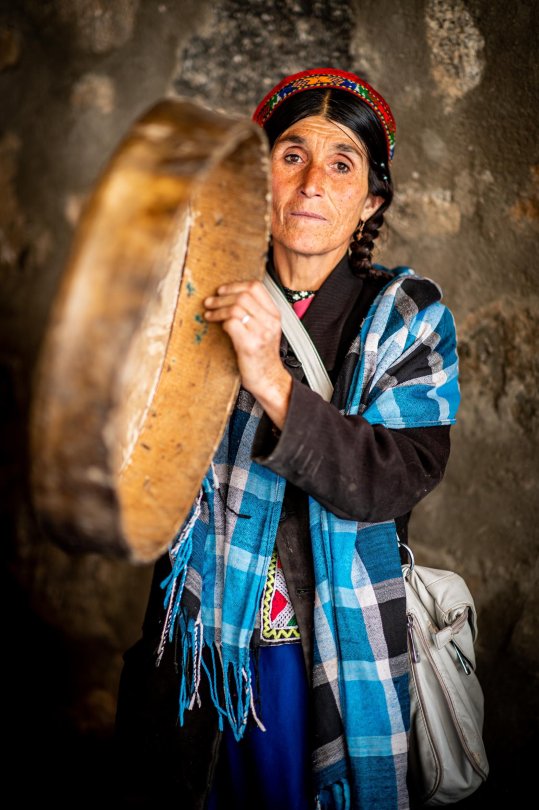
Afghan Woman Drumming, Afghan Market Outside Khorog, Tajikistan.
Afghanistan lies just a short walk across a bridge over the Panj River from the Afghan Market on the Tajik side of the border. Afghan market vendors walk their goods across the village from their nearby home villages on the other side of the river.
Source: The Humans Being Project
#tajikistan#afghanistan#afghan woman#afghan people#tajik#tajik people#pamir#badakhshan#market#village#drums#drum#instrument#music#tradition#traditional clothes#folk costume#rural#woman#high res
104 notes
·
View notes
Text
Facing floods and landslides, Afghans turn to nature for protection - Afghanistan
Facing floods and landslides, Afghans turn to nature for protection – Afghanistan
Amir Beg Khusrawi still has vivid memories of a flash flood that swept through his village in Afghanistan’s rugged northeast a decade ago.
“[It] destroyed around 20 houses, claimed livestock, and damaged our agricultural lands so that even now we are not able to use them,” says Khusrawi, 61.
His experience is not unique. In remote settlements across Afghanistan’s Pamir Mountains, deep in the…
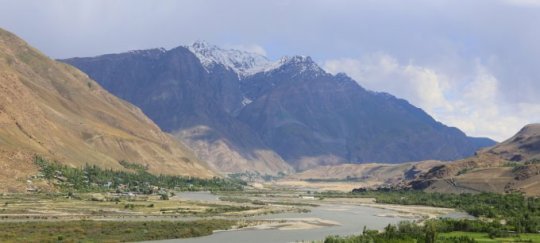
View On WordPress
0 notes
Photo
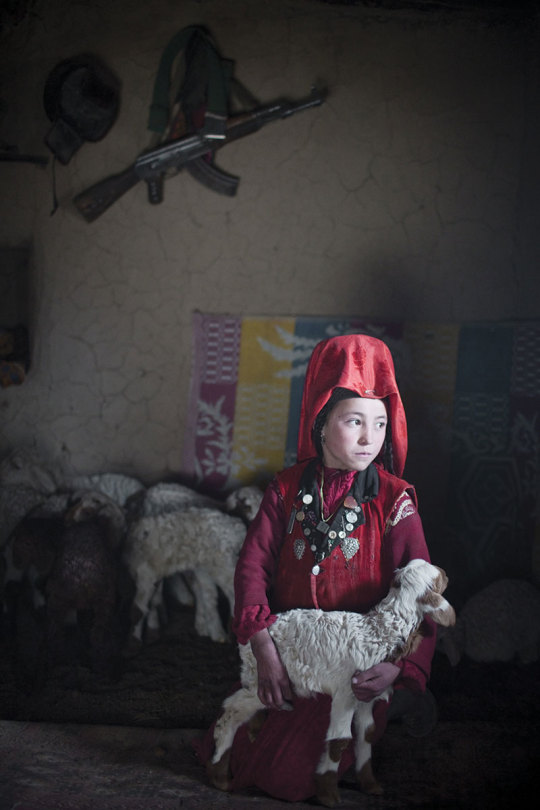
Prisoners of the Himalayas
On the roof of the world, a woman is worth a hundred sheep, but the salary of a shepherd is only one sheep per month. Women are scarce because most of them die at a young age during child birth.
The Kyrgyz of the Afghan Pamir have experienced famine, exile, war and persecution. The only place where they have found security and peace is the hidden depths of Central Asia. Despite the hardships and extremely inhospitable terrain, these people have managed to survive and maintain their traditional way of life against all odds.
#Prisoners of the Himalayas#Himalayas#roof of the world#Kyrgyz#Kyrgyz Girl#Pamir#Afghan Pamir#Central Asia#Badakhashan#Afghanistan
92 notes
·
View notes
Photo

Kyrgyz girl, Afghan Pamir, January 1971 © Sabrina and Roland Michaud ..
41 notes
·
View notes
Photo

Roland Michaud (Français, 1930-2020) Enfant Kirghiz, Pamir, Afghanistan, 1971 #Afghanistan #Afghan #pamir #fineartphotography #fineartphoto #colorphotography #colors #colorphoto #red #child #kid #kidsofinstagram #boy #cute #portrait #portraitphotography #portraitmood #portraiture #journey #trip #ethnic #profile #face #coat #hands #carpet https://www.instagram.com/p/CcGFQVZMYDt/?igshid=NGJjMDIxMWI=
#afghanistan#afghan#pamir#fineartphotography#fineartphoto#colorphotography#colors#colorphoto#red#child#kid#kidsofinstagram#boy#cute#portrait#portraitphotography#portraitmood#portraiture#journey#trip#ethnic#profile#face#coat#hands#carpet
6 notes
·
View notes
Photo

The Kyrgyz nomadic pastoralist and her herd.
Afghan fields, Afghanistan
Silvia Alessi
#afghan fields#afghanistan#afghan girl#silvia alessi#mountain#girl#pastoralist#shepherd#yak#sheep#livestock#remote#isolated#pamirs#pamir#kyrgyz#nomadic#dress#harsh altitude#culture#tradition#islamic republic of afghanistan#lumière du soleil#sunlight
5 notes
·
View notes